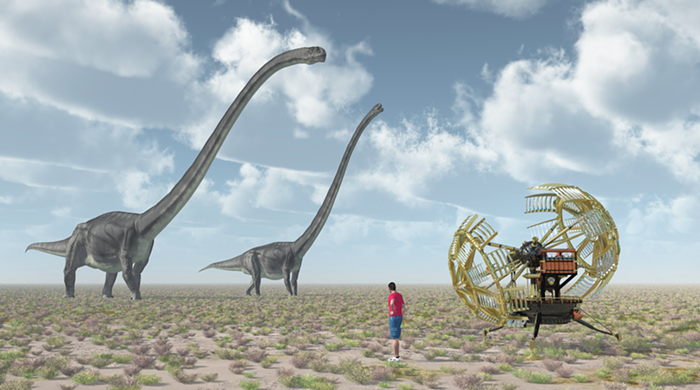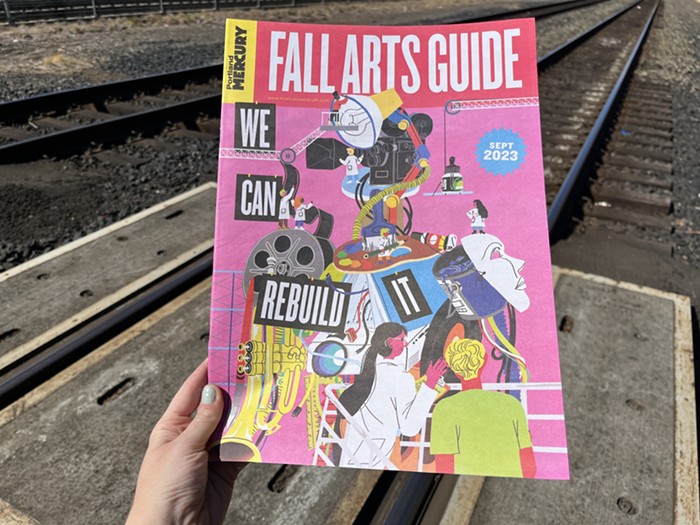“I always wanted to be the king of something,” says Chuck Legg. “I would have been the king of Lionel trains, but I didn’t have enough money. I was too late in life, and the stuff was gone. I came to the conclusion, ‘You know, hey, I could be the king of LaserDiscs.’”
And so much as anyone in America can be the king of anything, Chuck Legg is the king of LaserDiscs. In his suburban Tigard home, cardboard boxes full of them cover every horizontal surface that can bear the weight. They’re in the foyer and the hallways and on the stairs. There are boxes of LaserDiscs on the washer and dryer in the small laundry room, which leads to the big, two-car garage where the heart of his collection resides. Unremarkable from the outside, its interior is a maze of floor-to-ceiling shelves, each overflowing with discs organized by theme, franchise, or whim.
“I would say we’re at 15,000 discs in stock,” Legg estimates, referring to his business, Discount LaserDisc. Serving as “your online source for LaserDiscs,” the ancient-looking website has been operated by Legg for more than 20 years.
A dozen copies of GoodFellas lean against an equal number of Gone with the Wind. Star Trek box sets sit in a corner, tiny Shatners and Nimoys peeking from the gloom. Director’s cuts, music video compilations, and quasi-interactive murder mysteries crowd each other in tightly packed rows. Legg gestures to a shelf of 30 identical black spines.
“Dances with Wolves,” he says, exasperation in his voice.
I first met Legg at the 2018 Portland Retro Gaming Expo, where he’d set up a booth alongside other purveyors of obsolete technology. “I figured I’d bring some anime titles,” he said with a shrug, surrounded by 12-inch LaserDisc covers festooned with cartoon robots and schoolgirls. Kathy, Legg’s wife, wandered the periphery of their booth, chatting with curious bargain hunters.
As I flipped through careworn copies of Top Gun and Under Siege, one prospective customer loudly espoused the virtues of VHS cassettes, a stance quickly countered by a LaserDisc aficionado claiming that magnetic tape is too fragile. A few minutes later, they were arguing about whether squares are better than rectangles.
It’s entirely possible you’ve never seen even one LaserDisc—much less 15,000, as I now have. Only about 2 percent of US households ever had a LaserDisc player. (To describe a LaserDisc by comparing it to two other forms of outdated technology: A LaserDisc looks like a CD, if a CD was the size of a vinyl record.) The format, originally sold under the even more dated name “MCA DiscoVision,” was born alongside VHS in the late ’70s. But DiscoVision’s launch, says Legg, was “a total disaster.”
“They started in Atlanta,” Legg says. “There was a big, major department store—I guess there was a line around the block to get the players. And the next day the line was back: Everyone bringing them back because they didn’t work.”
LaserDisc quickly fell into a distant second place behind VHS. But the format endured long enough to develop a reputation for superior audio and video quality. While the VCR in your grandparents’ basement could output 250 lines of video to a TV screen, a half-decent LaserDisc player could do 425. That may seem like a rounding error in today’s age of 4K resolution, but in the mid-’90s, that meant you could watch movies in theatrical widescreen rather than a chopped-up pan-and-scan version.
“There were some widescreen VHS tapes, but if you wanted to see something in widescreen, generally it was on a LaserDisc,” says Grant Peterson, a projectionist at Portland’s Laurelhurst Theater. “You don’t want to see something pan and scan when you know you can see it widescreen.” Eventually, amenities we take for granted today—surround sound, chapter breaks, audio commentaries—found their way onto LaserDiscs.
“It was highest quality home-video format available on the market,” says Bill McFadden, an electrical engineer who, during LaserDisc’s heyday, worked in the TV division of Beaverton-based electronics manufacturer Tektronix. “Short of working at a TV studio, you were never going to see anything as good as that.”
The format limped through the golden age of analog physical media—the notoriously fussy Criterion Collection began life as a LaserDisc-exclusive imprint—but when the end came, it was swift.
In 1997, when DVDs started to enter the consumer market, there were around 30 places in Portland where you could buy or rent LaserDiscs, from specialty stores like Legg’s to the intriguingly named Lasers Exclusive and General Laser. Three years later, the final LaserDisc titles were trickling onto shelves, and only 17 Portland stores bothered to stock them.
That information comes courtesy of McFadden, who made a practice of calling local video stores, asking about their LaserDisc offerings, and posting the results to Usenet, which is the sort of thing people had to do before Google.
But nearly two decades on, Portland still has a LaserDisc scene—albeit a “scene” by the very low standards of a small community based around an old-school video format that few people ever had. The LaserDisc Database, an online archive where collectors document their collections, logs 87 users in Portland out of 3,546 nationwide. In the Facebook group “Portland LaserDisc, Console Gaming and Arcade Collecting,” members arrange trades and bemoan broken players and exasperated spouses. Collectors prowl thrift stores for holy grail finds to add to their collections. (Horror, anime, pop music, and porn still command high prices.) Portland even has a LaserDisc DJ: At his “Laser Vision” dance nights, King Fader spins LaserDisc clips of concerts, music videos, and “chase scenes.”
Near the end of our interview, Legg starts to eye me with suspicion.
“Are we gonna do the question,” he asks, “about the revival of LaserDiscs? Like records?”
We weren’t, but I can see how it’d come up. Sometimes dead media gets resurrected, as vinyl did in 2007 when sales, after decades of decline, suddenly started to climb. Even VHS is having a cultural moment thanks to nostalgia-heavy shows like Stranger Things.
Perhaps, then, another plucky analog medium is due for a comeback.
“The answer is no,” Legg says before I can ask. “What’s made is made. The plants are gone. There’s not enough market, and it’s a lot easier to make a record then a LaserDisc.”
According to a promotional documentary from Pioneer about the format’s manufacturing process, it’s immediately clear why vinyl’s easier to crank out: LaserDiscs had to be made in cleanrooms full of articulated lasers, chemical baths, and plastic lamination stampers. It was futuristic technology at the time, but these days most people seem content with Netflix.
“I’ve done this nearly 40 years,” Legg continues. “Every year in the ’80s and ’90s, it was, ‘Next year is going to be the year of LaserDisc!’ And it never really was.”
But Legg isn’t discouraged. When he talks about the oddball community that’s sprung up around the long-dead format, he seems as surprised as anyone.
“There was enough of a market in the Portland area that I could make a pretty good go of it. Now the question is, are we gonna get another year of business out of the collector market?” Legg asks. “If you would have told me in 2001 that in 20 years people would still be buying LaserDiscs, I wouldn’t have believed you.”
Ben Coleman is a writer from Portland with a LaserDisc collection that could be described as “modest.” His latest graphic novel, The Long Con Vol. 2, from Oni Press, contains several references to obsolete media and is available now.



















